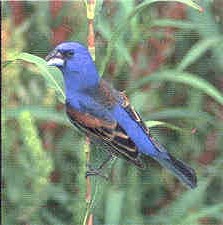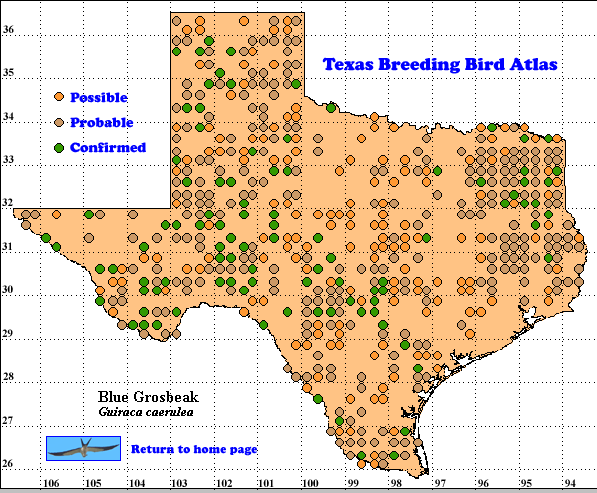Blue Grosbeak is a large bunting, now placed in the genus Passerina by the American Ornithologists’ Union, further removing it from other grosbeaks. The species is sexually dimorphic with delayed plumage maturation, so males in their first post-hatching year are essentially brown (like females of all ages), in contrast to the mostly blue plumage of fully adult males (Ingold 1993, Pyle 1995).
This species appears to be a common host for Brown-headed (Molothrus ater) and Bronze (M. aeneus) cowbirds, but more data are needed, not surprising for this poorly studied species (Ingold 1993).
DISTRIBUTION. During the 1987-1992 TBBA project field work, volunteers found Blue Grosbeaks breeding statewide, with records clustered most densely in northeastern Texas east of the 96th meridian and north of the 30th parallel. Other high concentrations of breeding reports are in south Texas below the 27th parallel and western Texas below the 31st parallel and west of the 99th meridian.
In other parts of North and Central America, Blue Grosbeaks breed from California east through southern Nevada and Utah, the Great Plains south from southern North Dakota, the Missouri and Ohio rivers, Pennsylvania and New Jersey, then south to the Gulf Coast states, the highlands of Mexico and Central America to Costa Rica and northern Baja California. Populations breeding in the United States and northern Mexico move south to winter throughout central Mexico and Central America (Ingold 1993).
SEASONAL OCCURRENCE. Blue Grosbeak is a summer resident, in Texas . Arrival dates extend from March 2 to June 2. Most spring migrants arrive between early April (early May in the Trans-Pecos region) and mid-May.
TBBA observers found pairs nest-building on May 15 and May 26, a nest with eggs on April 30, a bird on or near a nest on June 30, pairs feeding young from June 4 to July 15 and recently fledged young from May 25 to July 24. Departures occur between July 22 and November 24; most Blue Grosbeaks leave from the end of August to mid-October (Oberholser 1974, Lockwood and Freeman 2004).
BREEDING HABITAT. Blue Grosbeak breeds from sea level to 1800 m (6000 ft) in Texas in a variety of shrubby habitats across this varied state. They range from open country with scattered trees and bushes, brushy woodland edges, vine or brier tangles, overgrown fields and hedgerows to willows, cottonwoods or other stream-side vegetation (Oberholser 1974).
The deep, cup-shaped nest, placed on a branch of a tree or bush 1-2.5 m (3-8 ft) above ground, is made of leaves, plant stems, rrootlets, grasses, strips of bark, and sometimes bits of snake skin. Nests are lined with smaller rootlets, grasses and occasionally hair. The inside diameter is 6 cm (2.4 in) and the depth is 5 cm (2 in). The female lays 4, (range 3-6), usually unmarked bluish eggs. They are similar to the eggs of Indigo (Passerina cyanea), Lazuli (P. amoena), and Varied (P. versicolor) buntings, but larger. Blue Grosbeak eggs are unlike those of other grosbeaks. The female incubates the eggs for 11-12 days. Nestlings take their first flight after 9-10 days. Two broods per season are frequent (Oberholser 1974, Harrison 1979, Ingold 1993).
STATUS. Data from the Breeding Bird Survey (BBS) show Blue Grosbeak to be most common in Texas in an area extending from the northeast corner of the state along the Louisiana border south nearly to the Gulf Coast, and in the Trans-Pecos and Edwards Plateau regions (at densities between 3-10 grosbeaks detected per 40 km [25 mi]BBS route). In the Panhandle, the Rolling Plains, extreme south Texas and an area surrounding the region of high density in east Texas, density drops to 1-3 grosbeaks per BBS route (Sauer et al. 2004).
Lockwood and Freeman (2004) describe the species as a locally common to uncommon summer resident throughout most of the state. Blue Grosbeak is uncommon to rare in the Post Oak Savannah, Blackland Prairies and Coastal Prairie north of Aransas County. The species is a common to uncommon migrant throughout the state. Blue Grosbeak is a very rare winter resident along the Rio Grande River in southern Brewster and Presidio counties.
The TBBA map is quite similar to the summer and breeding records on Oberholser’s (1974) map, suggesting little change has occurred in the Texas range of this species from 1960 to 1992.
Blue Grosbeak was detected on 142 BBS routes in Texas, producing a 95% confidence interval of -2.7 to +1% population change per year for the period 1966-2003 (the odds are 19/20 that the actual trend will be between -2.7 and 1.0%). This analysis suggests any change in Blue Grosbeak numbers in Texas over this period has been relatively small. From the 1232 routes on which this species was detected across the United States the BBS method determined a statistically significant yearly population trend of +1.0%. The ratio of routes suggests Texas makes up an important part of the breeding range of this species (Sauer et al. 2004). Text by Robert C. Tweit (2005)
Literature cited:
Harrison, H. H. 1979. A field guide to western birds’ nests. Houghton Mifflin, Boston, MA.
Ingold, J. L. 1993. Blue Grosbeak (Guiraca caerulea). In The birds of North America, No. 73 (A. Poole and F. Gill, eds.). The Birds of North America, Inc., Philadelphia, PA.
Lockwood, M. W. and B. Freeman. 2004. The TOS handbook of Texas birds. Texas A&M University Press, College Station.
Oberholser, H. C. 1974. The bird life of Texas, Vol. 2. University of Texas Press, Austin.
Pyle, P. 1997. Identification guide to North American birds, part 1. Slate Creek Press, Bolinas, CA.
Sauer, J. R., J. E. Hines, and J. Fallon. 2004. The North American Breeding Bird Survey, results and analysis 1966-2003. Version 2004.1. USGS Patuxent Wildlife Research Center, Laurel MD (Web site, http://www.mbr-pwrc.usgs.gov/bbs).

